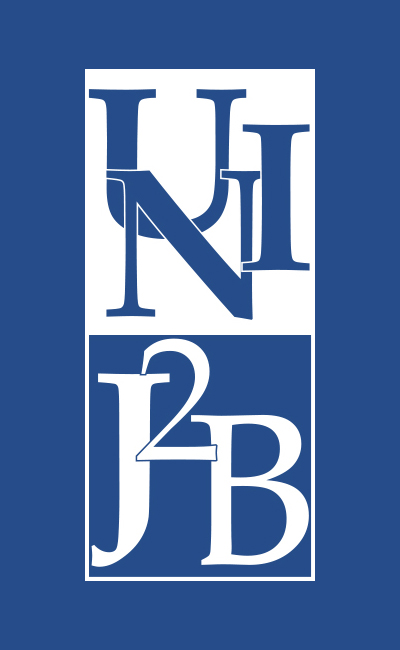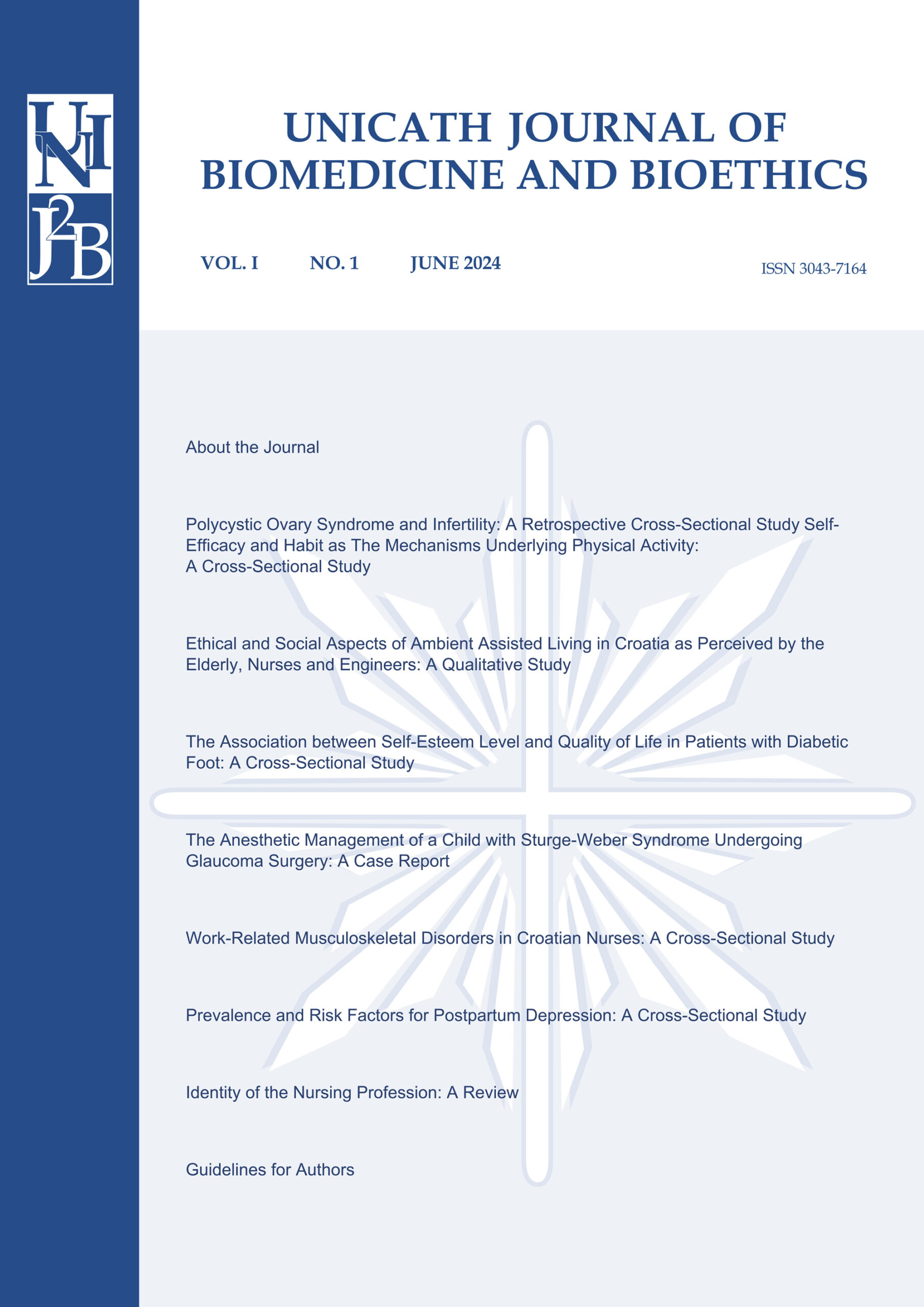UniCath Journal of Biomedicine and Bioethics
VOL. I • NO. 1
June 2024
Polycystic Ovary Syndrome and Infertility: A Retrospective Cross-Sectional Study
Self-Efficacy and Habit as The Mechanisms Underlying Physical Activity: A Cross-Sectional Study
Ethical and Social Aspects of Ambient Assisted Living in Croatia as Perceived by the Elderly, Nurses and Engineers: A Qualitative Study
The Association between Self-Esteem Level and Quality of Life in Patients with Diabetic Foot: A Cross-Sectional Study
Anesthetic Management of a Child with Sturge-Weber Syndrome Undergoing Glaucoma Surgery: A Case Report
Work-Related Musculoskeletal Disorders in Croatian Nurses: A Cross-Sectional Study
Identity of the Nursing Profession: A Review
Prevalence and Risk Factors for Postpartum Depression: A Cross-Sectional Study
Polycystic Ovary Syndrome and Infertility: A Retrospective Cross-Sectional Study
Nada Gruja1, Ana Tikvica Luetić1,2
Abstract
Background: Polycystic ovary syndrome (PCOS) is the most common endocrinological and reproductive-metabolic disorder in women, characterized by chronic ovulatory dysfunction, oligomenorrhea, hyperandrogenism and infertility. Infertility, the absence of a desired pregnancy with regular, unprotected intercourse for a period of at least one year, is a major public health problem today.
Aim: The aim of this retrospectively registered study was to examine the hormonal characteristics of infertile patients diagnosed with PCOS and compare them with a control group of infertile women not diagnosed with PCOS, of comparable ages and body mass indices.
Methods: In this retrospective cross-sectional study, the subjects were thirty patients diagnosed with PCOS treated for infertility at the Department of Obstetrics and Gynecology, Sveti Duh Clinical Hospital, who were compared to a control group of women not diagnosed with PCOS but diagnosed with infertility, of comparable ages and body mass indices. The data were collected from an electronic database, and the values of the observed indicators of the patients’ health status were presented in graphs and tables.
Results: The results show that there were statistically signifi cant differences in the levels of AMH, LH, E2 and FSH. In other words, the patients with PCOS had higher AMH and LH, and lower E2 and FSH, in comparison to women not diagnosed with polycystic ovaries of the comparable age and body mass indices. TSH and prolactin levels were comparable between the two groups.
Conclusion: Our study confi rmed that infertile patients diagnosed with PCOS have different serum levels of pituitary and ovarian sex hormones in comparison to the controls.
Keywords: Polycystic ovary syndrome, infertility, hormones
1University Department of Nursing
Catholic University of Croatia
Zagreb, Croatia
Nada Gruja
nada.gruja@unicath.hr
2Department of Obstetrics and
Gynecology
Sveti Duh Clinical Hospital
Ana Tikvica Luetić
ana.luetic@unicath.hr
ORCID 0000-0002-2074-8548
Corresponding author:
Assoc. Prof. Ana Tikvica Luetić, MD,
PhD
University Department of Nursing
Catholic University of Croatia
Ilica 242, Zagreb, Croatia
Department of Obstetrics and
Gynecology
Sveti Duh Clinical Hospital
Sveti Duh 64, 10000 Zagreb, Croatia
ana.luetic@unicath.hr
Self-Efficacy and Habit as The Mechanisms Underlying Physical Activity: A Cross-Sectional Study
Dragan Glavaš1, Vicko Ćudina1, Dražen Domijan2
Abstract
Background: In a modern, predominantly sedentary society, the importance of physical activity for both physical and mental health is increasingly emphasized. Hence, it is essential to examine the factors underpinning the initiation and maintenance of regular physical activity.
Aim: The main aim of this study was to test the role of physical activity (PA) self-efficacy and PA habit in explaining the PA intensity of recreational exercisers and athletes.
Methods: We conducted an Internet-based study from July 15 to July 31, 2023, using a cross-sectional design and a non-probability (convenient) sample. Participants completed a questionnaire containing scales to assess their PA self-efficacy, PA habit and PA intensity, questions on their physical exercise and sports involvement, and questions on their sociodemographic background.
Results: The study comprised 491 participants, of whom 424 were athletes (27.4%) or individuals who regularly exercise (72.6%), (53.8% of whom were female), of an average age of 28.39 years. The results showed a direct positive contribution of PA self-efficacy to PA intensity among athletes. PA self-efficacy did not directly contribute to PA intensity in exercisers. PA self-efficacy indirectly contributed to PA intensity through enhanced PA habit, across all the observed groups.
Conclusion: The study fi ndings demonstrated the importance of PA self-efficacy and PA habit in explaining PA intensity, with possible distinct mechanisms of contribution for athletes and regular exercisers. Specifi cally, the data suggest a positive impact of PA self-efficacy on PA intensity among athletes both directly and indirectly, through enhanced PA habit, while enhanced PA habit completely mediated the positive impact of PA self-efficacy on PA intensity among exercisers. This empirical evidence illustrates the necessity of providing individuals with effective skills and knowledge, which are crucial for fostering a sense of PA self-efficacy, strengthening the PA habit and, ultimately, for more effective engagement in PA.
Keywords: physical activity, recreational exercisers, athletes, self-efficacy, habit
1University Department of Psychology
Catholic University of Croatia
Zagreb, Croatia
Dragan Glavaš
dragan.glavas@unicath.hr
ORCID: 0000-0002-5950-855X
Vicko Ćudina
vcudina@unicath.hr
2Department of Psychology
Faculty of Humanities and Social
Sciences
University of Rijeka
Rijeka, Croatia
Dražen Domijan
ddomijan@ffri.hr
ORCID: 0000-0003-2589-3397
Corresponding author:
Assist. Prof. Dragan Glavaš
University Department of Psychology
Catholic University of Croatia
Ilica 242, 10000 Zagreb, Croatia
dragan.glavas@unicath.hr
Ethical and Social Aspects of Ambient Assisted Living in Croatia as Perceived by the Elderly, Nurses and Engineers: A Qualitative Study
Terezija Gložinić1, Anto Čartolovni2, Odilon-Gbènoukpo Singbo3
Abstract
Background: One of the major problems affecting the Western world is the rising increase of the elderly population. Consequently, society is looking to develop care and support systems for the elderly. Technological systems are being developed that aim to improve the quality of life of older people in order to afford them independence and autonomy. One such tool is Ambient Assisted Living (AAL), which implements various technologies into the homes of the elderly, contributing to their safety. The use of such technologies may lead to various social or ethical problems.
Aim: The aim of this study was to analyze the social and ethical issues of AAL and to understand the perceptions of the stakeholders in Croatia (the elderly, nurses and engineers) in detail.
Methods: We conducted qualitative research through semi-structured interviews with 17 participants from Croatia among three categories of people who could be potential stakeholders in the AAL system: nurses, engineers and the elderly. The interviews were recorded and then transcribed. The thematic analysis method was used to analyze the data.
Results: A total of fi ve nurses, six engineers, and six elderly individuals were interviewed. This study showed that there is a need to use AAL technology to improve the care and quality of life of the elderly. The participants were concerned about the potential of such technology to deprive the elderly of important human components of care, such as interpersonal warmth and touch, which might result in social isolation. The ethical issue of privacy breach due to constant video surveillance was a concern expressed by all the participants.
Conclusion: The greatest concerns regarding AAL found in this study were a lack of human contact, i.e., dehumanization of care, and the threat to privacy due to data collection using sensors and video surveillance.
Keywords: Ambient Assisted Living, smart homes, privacy, human contact, ethics, social isolation
1University Department of Nursing
Catholic University of Croatia
Zagreb, Croatia
Terezija Gložinić
tglozinic@unicath.hr
ORCID: 0000-0002-0219-756X
2Digital Healthcare Ethics Laboratory
(Digit-HeaL)
Catholic University of Croatia
Zagreb, Croatia
Anto Čartolovni
anto.cartolovni@unicath.hr
ORCID: 0000-0001-9420-0887
3Chair of Theology
Catholic University of Croatia
Zagreb, Croatia
Odilon-Gbènoukpo Singbo
odilon.singbo@unicath.hr
ORCID: 0000-0002-2154-8935
Corresponding author:
Terzija Gložinić
Catholic University of Croatia
Ilica 242, 10 000 Zagreb, Croatia
tglozinic@unicath.hr
The Association between Self-Esteem Level and Quality of Life in Patients with Diabetic Foot: A Cross-Sectional Study
Nina Hadžić1, Vilma Kolarić1,2, Viktorija Hefer1, Marin Čargo2
Abstract
Introduction: Diabetes is a global problem of modern times, and diabetic foot is an unpleasant complication of diabetes, which requires long-term, expensive and exhaustive treatment. Diabetes as a chronic disease can affect many aspects of an individual’s quality of life, and patients suffering from diabetes are usually at risk of developing low self-esteem.
Aim: This study aimed to determine whether there is a relationship between the level of self-esteem and the estimated quality of life in patients with diabetes and diabetic foot.
Methods: This study was conducted at the Institute for Diabetes and the Diabetic Foot Clinic of the Vuk Vrhovac University Clinic, Merkur University Hospital, Zagreb, Croatia, from February 2020 to October 2021. The participants were patients who suffered from diabetes and had diabetic foot as a complication. Data were collected using the Rosenberg Self-Esteem Scale (RSE) and the World Health Organization Quality of Life Questionnaire (WHOQOL-BREF).
Results: A total of 68 participants participated in the study. The quality of life of those included in the study worsened as the degree of diabetic foot worsened, and was the worst in the physical domain (F(2/65)=22.160; P<.01). Likewise, signifi cant positive correlations were obtained among all measures of quality of life and self-esteem. The higher the quality of life, the higher the level of self-esteem, and vice versa. The highest correlation was between the mental health domain and self-esteem (r=0.860**).
Conclusion: This study showed that quality of life is impaired in patients with diabetic foot and worsens as the diabetic foot worsens. Furthermore, it showed that the quality of life in these patients is also related to the level of self-esteem. Therefore, it is important to take all preventive measures and include all available resources in order to prevent the development of diabetes complications.
Keywords: diabetes, diabetic foot, self-esteem, quality of life
1Vuk Vrhovac University Clinic
Merkur University Hospital
Zagreb, Croatia
Nina Hadžić,
nina.hadzic00@gmail.com
Vilma Kolarić
vilma.kolaric@kb-merkur.hr
ORCID: 0000-0002-9085-1938
Viktorija Hefer
viktorija.hefer@gmail.com
2Catholic University of Croatia
Zagreb, Croatia
Marin Čargo
marin.cargo@unicath.hr
ORCID: 0000-0003-0189-4168
Corresponding author:
Marin Čargo, MN, MM, PhD candidate
Center for Evidence-Based Medicine
and Health Care
Catholic University of Croatia
Ilica 242, 10 000 Zagreb, Croatia
marin.cargo@unicath.hr
Anesthetic Management of a Child with Sturge-Weber Syndrome Undergoing Glaucoma Surgery: A Case Report
Tihana Magdić Turković1, Lidija Fumić Dunkić1,2, Ana Miletić1, Mirta Ciglar1
Abstract
Background: Sturge-Weber Syndrome (SWS) is a rare congenital neurocutaneous disorder characterized by leptomeningeal and facial hemangiomas, with consequent neurological and ocular manifestations. The anesthesia of these patients may be challenging and patients with SWS need careful assessment during the perioperative period.
Aim: The aim is to report on a case of successful anesthetic management for glaucoma surgery in a 3-year-old patient with Sturge-Weber Syndrome.
Methods: All the medical procedures on our patient were performed in the Sestre milosrdnice University Hospital Center. The patient fi rst underwent anesthesia to have her eyes examined and then to have glaucoma surgery. General anesthesia was introduced during both procedures.
Results: During both procedures, inhalational anesthesia with 8 Vol% sevofl urane was performed with the intraoperative addition of fentanyl for analgesia. Induction, as well as anesthetic emergence, went smoothly, without blood pressure oscillations. Maintaining blood pressure within normal limits was important, considering the risk of hemangioma rupture. Ibuprofen and paracetamol ensured adequate postoperative analgesia and no rises in blood pressure.
Conclusion: Since clinicians rarely encounter patients with SWS, it is important for all physicians involved in the treatment of such patients to become familiar with the challenges during the perioperative period. Therefore, we should like to emphasize specifi c anesthetic considerations for patients with SWS.
Keywords: Sturge-Weber Syndrome, anesthesia, glaucoma surgery
1Department of Anesthesiology
Intensive Care and Pain Management
Sestre milosrdnice University Hospital
Center
Zagreb, Croatia
Tihana Magdić Turković
tihana.magdic.turkovic@kbcsm.hr
ORCID: 0000-0003-1193-512X
Lidija Fumić Dunkić
lidija.fumic.dunkic@kbcsm.hr
ORCID: 0009-0009-8949-381X
Ana Miletić
ana.miletic@kbcsm.hr
ORCID: 0009-0000-3569-264X
Mirta Ciglar
mirta.ciglar@kbcsm.com
ORCID: 0000-0003-1508-270X
2Catholic University of Croatia
Zagreb, Croatia.
Corresponding author:
Mirta Ciglar
Department of Anesthesiology
Intensive Care and Pain Management
Sestre milosrdnice University Hospital
Center
Vinogradska cesta 29
10000 Zagreb, Croatia
mirta.ciglar@kbcsm.hr
Work-Related Musculoskeletal Disorders in Croatian Nurses: A Cross-Sectional Study
Marina Milaković1, Helena Koren1, Katarina Zahariev Vukšinić1, Marija Bubaš2
Abstract
Background: Work-related musculoskeletal disorders (WRMSDs) are the most prevalent group of health disorders related to work and working conditions, affecting more than half of all European workers. Nursing has previously been identifi ed as an occupation with a high risk of developing WRMSDs, in which occupational physical static and dynamic strains seem to play a role.
Aim: This study aimed to assess the prevalence of WRMSD-related pain and common occupational physical strains associated with nursing, as well as examine their association with various occupational factors.
Methods: A self-report-based questionnaire was constructed and self-administered by hospital nurses in Croatian hospitals/hospital centers.
Results: A total of 116 nurses participated in this study. The results indicate a very high prevalence of WRMSD-related pain as well as static and dynamic loading among hospital nursing staff. Low back (87.93%), neck (84.48%) and shoulder (81.89%) pain were the most prevalent. Statistical analysis revealed strong associations of wrist/hand pain with applying manual force while performing tasks and assuming working in awkward/forced postures of the wrist and the fingers; association of low back pain with general force, and an association of ankle/foot pain with age and years of employment.
Conclusion: Our study confi rmed some of the results of previous studies, suggesting a multifactorial etiology of WRMSD-related pain in hospital nursing staff, in which individual and occupational factors seem to play a role.
Keywords: musculoskeletal disorder, pain, workplace, physical work
1Division of Occupational Health
Croatian Institute of Public Health
Zagreb, Croatia
Marina Milaković
marina.milakovic@hzjz.hr
ORCID: 0009-0009-8267-6525
Helena Koren
helena.koren@hzjz.hr
Katarina Zahariev Vukšinić
katarina.zahariev-vuksinic@hzjz.hr
2Ministry of Health of the Republic of
Croatia
Zagreb, Croatia
Marija Bubaš
marija.bubas@miz.hr
ORCID: 0000-0003-2120-2974
Corresponding author:
Marina Milaković
Division of Occupational Health
Croatian Institute of Public Health
Radoslav Cimerman 64a
Zagreb, Croatia
marina.milakovic@hzjz.hr
Identity of the Nursing Profession: A Review
Gordana Jurić1,2, Ivica Matić2, Damir Važanić2,3
Abstract
Identity, including professional identity, is a dynamic process shaped by societal engagement and contextual factors. In nursing, the historical, social, cultural and political dimensions mold professional identity, with recent advancements emphasizing autonomy and collaboration. However, there still remains a gap in our understanding of how evolving roles impact nursing professionals’ identity and healthcare outcomes.
Professional socialization is crucial for nursing professionals, extending beyond technical skills to include soft skills, ethics and responsibilities. This lifelong process, infl uenced by education, mentorship and societal expectations, defi nes nursing’s professional identity. Ethical standards and values are foundational, shaping interactions with patients and colleagues. Policy implementation prompts role shifts, refl ecting changing healthcare needs, such as the expansion of nurse practitioner roles. Education, ethical practice and leadership are vital for shaping the future identity of nursing.
Nursing’s identity evolves with education, experience, societal needs and policy changes. Nurses are increasingly engaging in leadership and advocacy, impacting patient care and policy development. The future of nursing hinges on its adaptability to healthcare challenges and societal expectations. Scholarly works on professional socialization, nursing identity, policy implementation and the future of nursing provide insights into this evolution.
Keywords: nursing, professional identity, social values
1Zagreb Clinical Hospital Center
Zagreb, Croatia
2University Department of Nursing
Catholic University of Croatia
Zagreb, Croatia
3The Croatian Institute of Emergency
Medicine
Zagreb, Croatia
Gordana Jurić
gordana.juric@unicath.hr
ORCID: 0009-0001-2484-3817
Ivica Matić
ivica.matic@unicath.hr
ORCID: 0000-0003-4334-1158
Damir Važanić
damir.vazanic@unicath.hr
ORCID: 0000-0003-2003-9909
Corresponding author:
Assistant Professor Ivica Matić
University Department of Nursing
Catholic University of Croatia
Ilica 242, 10 000 Zagreb, Croatia
ivica.matic@unicath.hr
Prevalence and Risk Factors for Postpartum Depression: A Cross-Sectional Study
Karmen Sovulj1, Ana Šeremet2, Marta Čivljak3
Abstract
Background: One of the most important health problems affecting the mother and child is postpartum depression (PPD). This study aimed to determine the frequency and risk factors that contribute to PPD in order to help identify those at high risk and implement preventive measures.
Methods: We conducted a cross-sectional study in Zagreb, Croatia, from November 2022 to April 2023 on a convenient sample of mothers (N=195) with children up to six months of age, using the Edinburgh Postpartum Depression Questionnaire and the Multidimensional Scale of Perceived Social Support. The data were collected during home visits by visiting nurses or meetings of the Vita breastfeeding support group.
Results: Symptoms of PPD of varying intensity were present in 43 (22.05%) of the participants. It was found that the mothers with previous mental disorders (χ2=6.85, P=.01) and those less satisfi ed with their partners’ support (χ2=18.93, P=.00) had more depressive symptoms than those who did not have previous mental disorders and were satisfi ed with their partners’ support. Also, it was found that mothers with depressive symptoms had a lower level of support from their signifi cant others (t=3.96, P<.01), family (t=3.64, P<.01) and friends (t=3.39, P<.01) than mothers without such symptoms.
Conclusion: The prevalence of PPD in the sample was high, and it was shown that the following risk factors infl uenced its occurrence: previous mental disorders, dissatisfaction with emotional support from the partner, and a lower level of social support from signifi cant others, family and friends. It is important to raise awareness of this problem and recognize the symptoms in time, which could facilitate the implementation of appropriate preventive measures and the provision of appropriate therapy.
Keywords: postpartum depression, risk factors, prevalence, emotional support, social support
1Zagreb-Centar Health Center
Zagreb, Croatia
Karmen Sovulj
sovulj5@gmail.com
2University Department of Psychology
Catholic University of Croatia
Zagreb, Croatia
Ana Šeremet
ana.seremet@unicath.hr
ORCID: 0000-0002-6444-1337
3University Department of Nursing
Catholic University of Croatia
Zagreb, Croatia
Marta Čivljak
marta.civljak@unicath.hr
ORCID: 0000-0001-6211-0174
Corresponding author:
Ana Šeremet, PhD
University Department of Psychology
Catholic University of Croatia
Ilica 242, 10 000 Zagreb, Croatia
ana.seremet@unicath.hr


